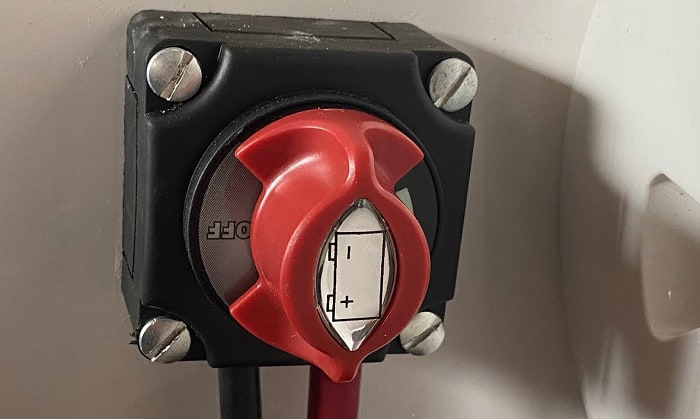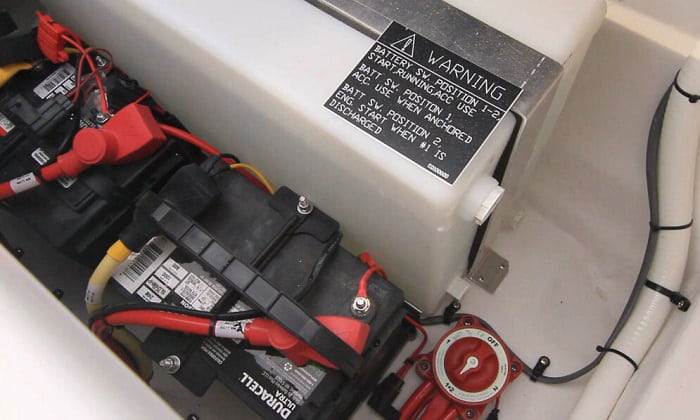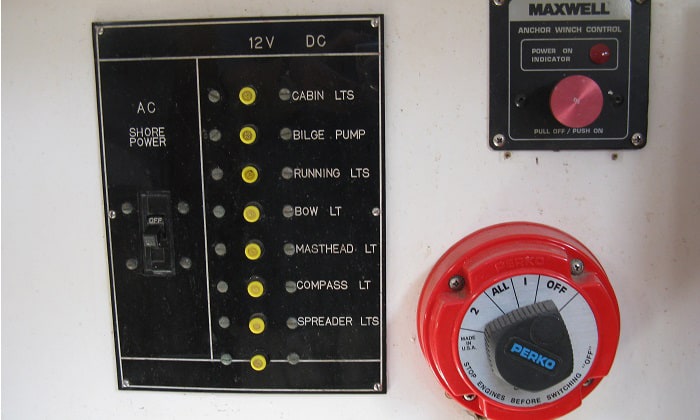A boat battery shut off switch is an excellent item to use when you want to safeguard your boat. When it comes to emergencies, the marine battery on off switch will be of great help.
Knowing how to install a battery disconnect switch on a boat makes every boating trip safe and worthwhile. This prevents starting or continuing to operate the boat unintentionally. You can do this marine battery disconnect switch installation quickly and easily.
Table of Contents
- Tools You’ll Need for the Installation
- Here are the Seven Steps to Follow on Installing the Battery Kill Switch to Your Boat
- Step 1: Purchase A Battery Kill Switch
- Step 2: Disconnect Both Battery Wires On The Boat’s Battery
- Step 3: Remove The Battery Ground And Solenoid Connection
- Step 4: Connect The Kill Switch Wires
- Step 5: Reconnect The Battery Terminals
- Step 6: Determine the location of the kill switch
- Step 7: Connect the Kill Switch to the Frame
- Step 8: Connect the Battery Cables
- Conclusion
Tools You’ll Need for the Installation
1. Battery Switch
A dual circuit plus battery switch is installed (OFF-ON-COMBINE) to separate a motor battery from the boat’s housing bank. Check that the engine’s battery is linked to the starter when switching ON.
Ensure the battery has housing loads connected to the housing battery bank. Also, disconnect switches for batteries are heavy-duty devices. Purchase only the correct goods and check the following:
- The switch amperage should be greater than the battery ampere.
- The usual battery voltage is 12 Volts minimum for boats.
- Terminals made of brass or stainless steel work well.
- Switches having an IP65 rating can resist severe weather conditions.
2. Phillips Screwdriver and Screws
These screwdrivers are designed to accommodate Phillips head screws that feature a cross-shaped recess, thus the term cross screwdriver. They were created to deal with increased torsion.
Meanwhile, Phillips screw heads provide for a tighter fit than flat head screws. That is why most manufacturers and handymen use this tool. The screw’s size is commonly tiny and light. The key is to use a screwdriver that is compatible with the kind and screw size you are using.
3. Socket Wrench
A socket wrench’s job is to loosen or tighten connectors like nuts and bolts, without having to reposition the tool just on the fastener. This is necessary when turning a wrench in a complete circle isn’t possible. It may help shorten the process of tightening battery and terminal fasteners.
Socket wrenches also have a long pole to which several size sockets may be connected to tighten various size bolts. As a result, it’s important to select the correct socket size for the specific fastener.
4. Silicone Caulking
Caulk or is a substance used to seal gaps or seams in different constructions and pipes against leaking. The gel-like material will be pushed into the gaps shaped like wedges between the surface of your boat and the screws attached to put the switch in place.
You can use the tip of your finger when smearing the caulk around the screwed areas. Ensure there are no gaps where water can come in. Also, you can try putting a dab before you screw the switch on the surface, then squeezing in between when tightening the screws.
5. Drill Bits and Drill
Drill bits are used to make holes in a number of different materials, including boats’ surfaces. This tool will be used to bore holes that match the sizes of the switch’s screw holes. It will also help easily screw the kill switch in place, securing it from moving around.
Ensure buying the appropriate sizes. If it’s too big, the drilled hole will be too loose for the screw to hold the switch to the boat’s surface. But if it’s too small, it will be too tight for the screws to dig and may cause rougher edges, which, in turn, can scrape the wirings of the switch or appeal less on the boat.
6. Safety Insulating Gloves
Rubber insulating gloves while dealing with battery cables and terminals may be the essential piece of protection to wear. Electrical safety gloves must have dielectric characteristics, physical strength, flexibility, and durability to be effective.
This is because lead-acid batteries contain explosive hydrogen-oxygen fumes and sulfuric acid, which may inflict serious burns. When working or handling a lead-acid battery, take these measures to prevent risk and harm. When there are electric leakages as you work with the battery and disconnect switch.
Here are the Seven Steps to Follow on Installing the Battery Kill Switch to Your Boat
Step 1: Purchase A Battery Kill Switch
When installing the battery switch, the kind of switch you purchase must be carefully considered. Look in the owner’s handbook for information about the boat’s battery and other components’ power output. This should be matched up with the battery kill switch so you won’t encounter a few problems.
In case you have lost the battery’s manual or handbook, don’t hesitate to ask for advice from the right people. Because having the right battery kill switch ensures that it matches the voltage flow capacity of your switch. Moreover, going over what is recommended means you’ll unnecessarily spend additional money.
Step 2: Disconnect Both Battery Wires On The Boat’s Battery
When working on electrical components, you should always separate both the negative and positive wires from the battery rods to guarantee your safety. Cleaning the connections, wires, and connecting points while the cables are disconnected from the battery rods is a good idea.
Also, don’t forget to take photos or sketch anything so you know battery orientation and what wires go back where. This will ensure that you will reconnect the wires on the right connectors, especially if this is your first time. Plus, you don’t have to rummage in your brain later about what goes where.
Step 3: Remove The Battery Ground And Solenoid Connection
Your battery’s negative terminal is connected to the body of the boat. It acts as the current return route. That is why you must disconnect the cable that connects the batteries to the boat’s body. While installing the switch, it may avoid any unintentional short circuits.
If you don’t have an originally installed switch, you’ll need to use the battery switch the bypass of the boat starter’s connection. Disconnect the connector between both the starting and the battery solenoid first.
Step 4: Connect The Kill Switch Wires
You may now set up the switch after removing the terminal. Connect it to a cable as well as the battery terminal using wire. Then, the length between your switch and the main battery should be measured. Cut a cable the same length as the first.
Also, it’s simpler to handle your wires if you put the batteries together. Cut a portion of another wire again from the switch disconnector to the solenoid starter. Keep in mind that the battery connection may be rated higher than the other electrical cables.
Step 5: Reconnect The Battery Terminals
Reconnect the positive connection to the battery terminal. Ensure that it is securely fastened without damaging any one of the wires. For reconnecting the positive wires, assume you’re working with a three-terminal switch. Connect each battery’s positive terminals to the switch’s two inlets. It’s an important step because no battery cables should be connected to the switch’s output terminal.
After that, connect the solenoid to the switch output terminal. To avoid any chances of accidents caused by sudden electric flow, make sure that the switch is now turned off. Then, connect each battery’s negative terminals to the ground pin or the boat’s body.
Step 6: Determine the location of the kill switch
To avoid electrical leakages, the switch should be placed closer to your batteries. Above all, it should be in a convenient position for the boat user. By making it so, the kill switch is easily found in case of emergencies without causing you any panic tendency.
Also, when the switch is near the battery, you can use less cable. This saves you money, time, and effort from doing complex power switches.
Step 7: Connect the Kill Switch to the Frame
Mark the position of the screw holes in the battery switch housing using a marker. Drill holes and ensure that any extrusions that remain are removed. Line up the battery switch holes with the slots you drilled and fasten them with the provided screws.
Apply a smear of the silicone caulk to the wire connections to serve as a waterproofing agent and prevent the wire connections from corroding and falling out.
Step 8: Connect the Battery Cables
You may now reconnect the battery terminals to the battery poles once the battery disconnect switch has been fitted. Then, do some testing to see if it works by turning on your boat’s engine then turning the kill switch. If the boat’s engine shuts down as expected, it works perfectly fine. Otherwise, you need to turn off the kill switch and check the connection of the cables.
Conclusion
Knowing how to install a battery disconnect switch on a boat is essential to the success of your boating trips. Use these tiny devices to install and improve the safety and security of your boat. You may choose between key and lever operating switches, depending on your preference. Whatever your choice, don’t leave your boat without this vital safety device for ease and safety.

“I am James Harvey – founder of Boating Basics Online. It is established with the drive to help out first-time boaters, which are those desiring to explore their way through the water. So if you are new to boating, start from here with me. “



